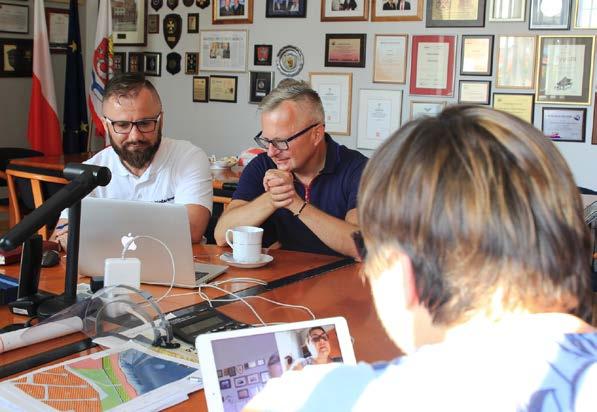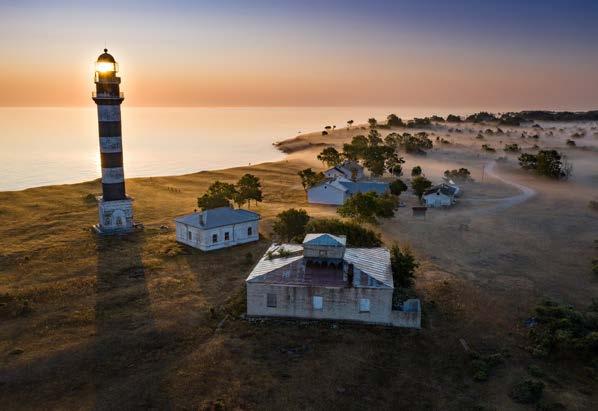
5 minute read
Tourism destination with sustainable soul
TOURISM DESTINATION
WITH SUSTAINABLE SOUL
Advertisement
Photo: Visit Jyväskylä / Oravivuori Triangulation Tower by Jukka Paakkinen
Jyväskylä region in the Finnish Lakeland is a tourism destination with a naturally sustainable soul. This soul with responsible roots takes its growing power from the lakes, forests, never-ending paths, sauna, and silence.
Pandemic and new strategy
However, no matter how sustainable and responsible this region is, the tourism was much affected by the Covid-19. For several months in spring 2020 restaurants, hotels and cafés were closed, events cancelled, and people moved their offices to kitchen tables and sofa corners at home.
Visit Jyväskylä, the official destination marketing and management organization in the region and part of the City of Jyväskylä, did not for its part get paralyzed. On the contrary, the team quickly changed its strategy from international and domestic marketing to domestic only with a strong focus on locals.
This was clearly a wise decision; the locals found the Visit Jyväskylä website where the team gathered a comprehensive list of local services that were open despite the pandemic.
“We focused on serving the locals and clearly understood our responsibility to support with marketing actions those who were struggling in the completely new situation”, states Visit Jyväskylä Tourism Director Ms. Susanne Rasmus.
From responsible local tourism…
Together with the summer arrived better days for the local tourism. Visit Jyväskylä continued its new strategy in doing socially responsible marketing. Everybody understood that by Johanna Maasola | Johanna.Maasola@jyvaskyla.fi this is now the time to show people living in Lakeland, Jyväskylä region what a crown jewel they have just around the corner.
Locals and the Finns were clearly the right segments as many tourism operators in the region broke their records during summer months. Locals found the services that had earlier attracted international guests in growing numbers.
The pandemic opened the eyes and shifted the way of tourism to socially and in many ways ecologically responsible this year.
…to responsible international tourism
During the pandemic, Visit Jyväskylä team has stayed in contact with cooperators and stakeholders across the national borders.
“We have gathered information from travel and tourism industry and are very confident that once the situation gets stable, our region attracts again the international guests due to our strengths. Our regional sustainable soul, responsible way of doing things with pure nature, natural distances and clean environment make our region a safe place to visit no matter the nationality”, concludes Ms. Rasmus.
IN THE KRØGENES AREA IN ARENDAL

Photo: Batfish
In 2019, Arendal municipality was granted financial support from the Klimasats fund (Climate action) from the Norwegian Environment Agency to make a feasibility study on green mobility and social sustainability in the Krøgenes-Vindholmen area in Arendal, Norway. This was an alternative to a more traditional public area-planning process.
The plan to develop Krøgenes suburban area and the closely related area of ”Bryggebyen/Vindholmen” that was recently regulated from industry to a residential area, is anchored in the Area and transport plan for the Arendal region. Co-creation connected to development projects is building on the civil society strategy in Arendal, and the societal part of the overall municipal plan, which is based on the UN sustainability goals.
The Innovation strategy and Business policy action plan 2017-2023 are also giving guidelines for a smart, inclusive and innovative approach. The project is a pilot in the network ”Short-travelled quality” hosted by the organization of municipalities in Norway, KS.
The work started out based on an established collaborative approach in Arendal, a Penta Helix model that has been developed both through previous projects such as With a Heart For Arendal and the national pilot project initiated by DOGA, Sparkling Spaces, where Arendal was one of three pilot cities.
A systematic interaction between the municipality, business, cultural life, citizens, organizations, research and development, established, to cultivate a ”care for each other” -culture, and develop smart and relational infrastructure. An inclusive business sector, diversity and social entrepreneurship are core values in the project. The project is combining green mobility, social sustainability, compact and quality-oriented building approaches, as well as smart business development. by Lisbeth Iversen | Lisbeth.Iversen@arendal.kommune.no The PÅDRIV / Front Runner-method tested out in Hovinbyen, Oslo, has been chosen as the overarching approach for the project. The UN sustainability goals are connected with site-specific development goals. In the Front runner- initiative, ”top-down” and ”bottom-up” approaches are combined in order to connect and coordinate actors, methods, needs and wishes, and to secure implementation-power in the project.
An interdisciplinary and cross-sectoral steering group and an internal working group are guiding the collaboration. A public sector PhD candidate in the municipality is participating through action research, testing out new methods and ways of working, participating both in the steering group and working group of the project.
The project addresses social sustainability and belonging, through mobilization of local resources. Solutions for green mobility, meeting places, housing and smart business development are being developed through placemaking approaches and co-creation.
Due to Covid-19, all the ongoing public meetings and activities stopped in March. This crisis forced the collaborating actors to use new methods to continue the co-creation between the actors, such as digital meetings, smaller social meetings, local walks with one person at the time, and dialogues with smaller groups of school children . In addition a questionaire was launched through Facebook, and people were also informed about the possibility to mark walkways, meeting places, wishes or concerns, in a digital map for the area.
This combined and tailor-made approach has turned out quite successful, and has provided broad knowledge, and a platform to build on for the development of a sustainable, green and inclusive environment.

Photo: Lisbeth Iversen
With a clear focus also on the next generation of business, and on the UN goals 11 and 17 especially, the project was selected by DOGA, Design and architecture Norway, as a good example of how the municipality in collaboration with local actors can take a proactive role as a sustainable community developer.
DOGA is an organisation which promotes the use of design and architecture to support private and public sector innovation. The example from Arendal became part of a best practice book on smart and sustainable urban and local development in practice, launched by DOGA in September 2020.
Through co-creation in this Front-runner initiative, Arendal municipality wishes to ensure increased quality and climate focus in spatial- and transport planning, establish green connections and mobility solutions, quality of urban life and inclusive meeting places and urban spaces, beyond what one might expect from ordinary spatial planning.
The goal is to generate new knowledge, tools, and new methods that can be used in the future planning work, and move us from planning intentions to more democratic place leadership, place management, and place innovation.
Film from the Area: https://medhjerteforarendal.no/krogenes-vindholmen/











